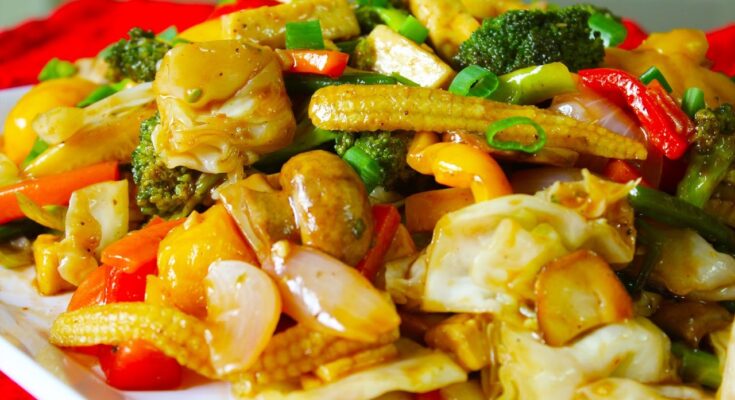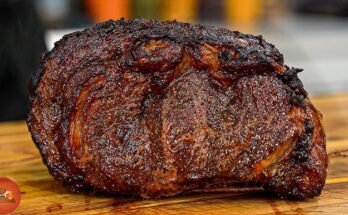Vegetable Stir Fry Recipe: Imagine coming home after a long day and whipping up a fresh, tasty dinner in less time than it takes to order takeout. That’s the magic of stir fry. This dish is a go-to favorite for many because it’s super versatile, fast, and doesn’t leave a mountain of dishes behind.
A vegetable stir fry is a dream when you want to eat healthy without sacrificing flavor. You can toss in any vegetables you have lying in the fridge—broccoli, bell peppers, carrots, snap peas, and more—and the results are always satisfying. Plus, it’s a one-pan wonder. Who doesn’t love fewer dishes to wash?
You also control the ingredients. No more worrying about hidden sugars, too much sodium, or mystery oils. You get fresh, vibrant veggies, cooked just right, and tossed in a flavorful homemade sauce that puts restaurant versions to shame.
Nutritional Benefits of Stir Fry
Beyond the flavor and convenience, there’s a big health win with stir fry. Since you cook vegetables quickly over high heat, they retain more nutrients than in boiling or slow-cooking methods. The result? Crunchy textures, rich colors, and a power-packed nutritional punch.
Here are just a few health perks:
- Fiber-rich: Great for digestion.
- Low in calories: A guilt-free, filling meal.
- Packed with vitamins: Depending on your veggie choices, you can get A, C, K, and even iron and calcium.
- Customizable for diets: Whether you’re vegan, gluten-free, or watching carbs, stir fry has you covered.
Essential Ingredients for a Delicious Vegetable Stir Fry
Fresh Vegetables You Can Use
The beauty of stir fry lies in its adaptability. You can use almost any vegetable, depending on what’s in season or what’s in your fridge. That said, the most popular veggies that work great for texture and flavor include:
- Broccoli: Adds crunch and soaks up sauce.
- Bell Peppers: Sweet and colorful.
- Carrots: A pop of color and mild sweetness.
- Snow Peas/Snap Peas: Crisp and slightly sweet.
- Zucchini: Soft texture when cooked briefly.
- Mushrooms: Earthy flavor and meaty texture.
- Onions: Slightly caramelized, adds depth.
- Cabbage or Bok Choy: Crunchy and fresh.
Mix and match depending on your preferences. The trick is to combine a variety of textures—some firm, some tender—for a balanced bite.
Key Sauce Components
What brings everything together in a stir fry? The sauce. A good stir fry sauce should hit that savory-sweet-umami trifecta. Here’s a simple base sauce:
- Soy Sauce (or Tamari for gluten-free): Salty and rich.
- Sesame Oil: Adds nuttiness and depth.
- Garlic & Ginger: For aroma and zest.
- Rice Vinegar or Lime Juice: A splash of acidity.
- Brown Sugar or Honey: For that hint of sweetness.
- Cornstarch Slurry (cornstarch + water): Thickens the sauce so it coats every veggie.
Tweak it to your taste—spicy, tangy, or sweet. That’s the stir fry freedom.
Optional Add-Ons for Extra Flavor
Want to level up your stir fry? Consider these extras:
- Tofu or Tempeh: Protein-packed and soaks up flavors.
- Cashews or Peanuts: Adds crunch and richness.
- Chili flakes or Sriracha: For some heat.
- Fresh herbs like cilantro or green onion: A fresh, bright finish.
With just a few tweaks, you can turn a simple stir fry into a masterpiece that tastes different every time.
Tools You’ll Need
The Importance of a Wok or Skillet
When it comes to stir frying, your choice of pan can make or break the dish. A traditional wok is your best friend—it has a rounded bottom and high sides, perfect for tossing ingredients quickly and evenly over high heat. But don’t worry if you don’t have one—a large nonstick or cast iron skillet will work just fine.
Here’s why a wok rules:
- Distributes heat evenly.
- Prevents overcrowding.
- Allows you to stir quickly without spilling.
- Retains high heat for that signature stir fry “sear.”
Just remember—whatever pan you choose, make sure it’s hot before adding anything. That’s the key to quick cooking and preventing sogginess.
Other Useful Kitchen Tools
To make your stir fry smooth and simple, keep these tools on hand:
- Sharp Chef’s Knife: For slicing and dicing your veggies cleanly.
- Cutting Board: A stable surface to prep everything.
- Mixing Bowls: Great for separating chopped ingredients.
- Wooden Spoon or Spatula: Helps stir without scratching your pan.
- Grater or Microplane: For ginger and garlic.
Having your tools prepped and ready makes cooking so much more fun—and keeps things stress-free.
Preparing for Stir Fry Success
Chop Everything Before You Cook
One golden rule: stir fry waits for no one. Once you start, it’s go time. Everything happens fast, and if you’re still chopping carrots while your garlic is burning in the pan… well, that’s a mess.
So take a few minutes before you turn on the stove to prep all your ingredients:
- Wash and dry your veggies.
- Chop them into bite-sized pieces.
- Measure your sauce ingredients in a bowl.
- Set everything in separate bowls so it’s ready to toss in.
This method is called mise en place (a French term meaning “everything in its place”), and it will make you feel like a kitchen pro.
Tips for Uniform Cutting and Cooking Times
Another key to success? Uniform size. Vegetables that are the same size cook at the same rate. If your carrots are chunky and your zucchini is thin, one will be raw while the other turns mushy.
Here’s how to handle the most common veggies:
- Carrots: Slice into thin matchsticks or half-moons.
- Bell Peppers: Cut into thin strips.
- Broccoli: Break into even-sized florets.
- Zucchini: Halve lengthwise, then slice.
- Onions: Thin wedges or strips work best.
And remember: some veggies take longer to cook than others, which we’ll cover in the next section.
Step-by-Step Guide to Making Vegetable Stir Fry
Step 1 – Heat the Pan Properly
This is where the magic begins. Getting your pan hot—really hot—is non-negotiable if you want a proper stir fry. Whether you’re using a wok or a regular skillet, crank up the heat and let it preheat for a minute or two until it’s almost smoking. You’ll know it’s ready when a drop of water sizzles and evaporates instantly.
Why is this important? Because high heat:
- Helps sear the vegetables.
- Locks in moisture without making them soggy.
- Cooks quickly while preserving crunch and color.
Add your oil only after the pan is hot. Use oils with a high smoke point like:
- Canola oil
- Avocado oil
- Grapeseed oil
- Peanut oil
Avoid olive oil—it burns too easily. Swirl the oil to coat the bottom of the pan evenly. Once that’s done, you’re ready to toss in the first layer.
Step 2 – Start with Aromatics
The first thing to go into your hot, oiled pan should be aromatics. These are the flavor-builders of any good stir fry, and they’ll set the tone for your entire dish.
Typical aromatics include:
- Garlic (minced)
- Fresh ginger (grated or finely chopped)
- Chopped green onions or shallots
Cook these for no more than 30 seconds to 1 minute, constantly stirring. You want them fragrant, not burned. This quick flash-cooking wakes up their flavor and infuses your oil—setting the stage for everything else that follows.
Optional: Add a pinch of chili flakes if you want to bring in some heat at this stage.
Step 3 – Add Hard Vegetables First
Not all veggies cook at the same rate. The ones that take longer to get tender should go in first. This usually includes:
- Carrots
- Broccoli
- Cauliflower
- Green beans
Toss them in and stir constantly so they don’t burn. You’re looking to sear and soften, not steam. Keep the heat high and the veggies moving every few seconds to avoid sticking.
If you notice things getting too dry or starting to scorch, you can add a splash of water or veggie broth to deglaze the pan slightly and create a bit of steam—but only a splash. You still want crisp-tender textures, not limp veggies.
Let these harder vegetables cook for 3 to 5 minutes, depending on how thick you’ve cut them.
Step 4 – Softer Vegetables Come Later
Now it’s time to layer in the veggies that cook faster:
- Bell peppers
- Zucchini
- Snap peas
- Mushrooms
- Spinach or leafy greens
These should only take 2 to 3 minutes to cook. They’ll soften and release some of their natural moisture, helping balance the texture of the dish.
Be careful not to overcrowd the pan here. If you’re cooking for a large group, do it in batches to keep the stir fry crisp instead of soggy. You want each piece to have contact with the pan, not just sit in a heap and steam.
Keep stirring and flipping until everything looks glossy, slightly caramelized, and vibrantly colored.
Step 5 – Pour in the Sauce and Toss
This is the grand finale. Your veggies are cooked, your pan is sizzling—now it’s time to bring it all together with that flavorful sauce you prepped earlier.
Give the sauce a quick stir (especially if it has cornstarch, which settles fast) and pour it evenly over the veggies. It should hit the hot pan and start bubbling right away.
The sauce will:
- Coat the veggies.
- Thicken up due to the cornstarch.
- Bind all the flavors together.
Toss everything for 1 to 2 more minutes until the sauce thickens into a glossy glaze and clings to the vegetables. Taste and adjust seasoning—maybe an extra splash of soy sauce or squeeze of lime if you want more zing.
Now turn off the heat and serve it up while it’s piping hot. You’ve just made a perfect stir fry from scratch!
Serving Suggestions and Pairings
What to Serve with Vegetable Stir Fry
While vegetable stir fry is satisfying on its own, pairing it with the right side can take it to the next level. Here are some classic and creative serving options:
- Steamed White or Brown Rice: The most traditional choice. It soaks up the flavorful sauce beautifully.
- Fried Rice: A fun twist that adds extra depth, especially if you have leftover rice.
- Noodles: Rice noodles, soba noodles, or lo mein work great with stir fry. Just toss them in at the end or serve underneath.
- Quinoa: For a healthier, protein-packed base.
- Cauliflower Rice: A low-carb, gluten-free option that still gives you a full, hearty meal.
Want to go fancy? Serve your stir fry in a pineapple bowl for a tropical presentation that’s as eye-catching as it is tasty.
Toppings and Garnishes
Don’t skip the garnishes! They add flavor, crunch, and visual appeal:
- Toasted sesame seeds
- Chopped scallions
- Fresh cilantro
- Crushed peanuts or cashews
- A drizzle of sriracha or sesame oil
These little touches go a long way in making your homemade stir fry feel like restaurant-quality.
Customizing Your Stir Fry
Make It a Complete Meal
If you want your stir fry to be more filling or protein-rich, consider adding one of these options:
- Tofu: Pressed, cubed, and pan-fried until golden. Then toss in with the veggies.
- Tempeh: Slightly nutty and hearty—marinates well.
- Chickpeas: Adds a creamy texture and tons of fiber.
- Paneer or Halloumi: For a vegetarian-friendly cheesy twist.
- Scrambled egg: Like in fried rice, adds a little protein boost.
These additions help turn your veggie stir fry into a complete, balanced meal without complicating the recipe.
Spice It Up (Or Down)
Love heat? Add some chili garlic sauce, fresh chopped chilies, or a splash of hot sauce. Not a fan of spice? Simply omit the spicy ingredients and focus on the sweetness and umami instead.
You’re in full control here—this recipe bends to your preferences like a culinary chameleon.
Make-Ahead and Storage Tips
Meal Prep Friendly
Vegetable stir fry is a meal prep MVP. You can chop all your veggies ahead of time and store them in airtight containers for up to 3 days. Keep them grouped by cook time—hard veggies in one container, soft ones in another—so you can toss them into the pan in the right order.
Even the sauce can be made ahead and stored in a jar in the fridge. Just shake well before using.
Storage and Reheating
Got leftovers? Lucky you. Here’s how to handle them:
- Storage: Store cooled stir fry in an airtight container in the fridge for up to 3–4 days.
- Reheating: Best done in a skillet over medium heat with a splash of water or broth to loosen the sauce. Microwaving works too, but the texture may soften more.
Avoid freezing if possible—most veggies lose their crispness after thawing.
Common Mistakes to Avoid
Overcrowding the Pan
The biggest stir fry mistake? Throwing everything into the pan at once. This causes the veggies to steam instead of stir-fry, and you lose that crisp-tender texture.
Cook in batches if you have to. A hot, uncrowded pan = stir fry success.
Not Prepping Ahead
Stir frying is fast-paced cooking. If you’re still chopping veggies or measuring sauce when the pan is already hot, you’re asking for chaos. Always prep everything beforehand.
Using Too Much Sauce
It’s tempting to drown your stir fry in sauce, but this can make the veggies soggy. A little goes a long way, especially with a well-balanced, flavorful sauce.
FAQs about Vegetable Stir Fry Recipe
1. What vegetables work best in a stir fry?
A mix of colorful, crisp vegetables like bell peppers, broccoli, carrots, snap peas, and baby corn work best. You can also add mushrooms, zucchini, or bok choy depending on your taste.
2. Can I use frozen vegetables for stir fry?
Yes, frozen vegetables can be used. Just make sure to thaw and pat them dry before cooking to avoid excess moisture in the pan.
3. What kind of oil is best for stir frying?
Use high smoke-point oils like sesame oil, vegetable oil, peanut oil, or sunflower oil. These help cook quickly without burning.
4. Do I need a wok to make stir fry?
Not necessarily. While a wok is ideal due to its high sides and quick heat distribution, a large skillet or frying pan can also work well.
5. How do I keep vegetables crisp in stir fry?
Cook on high heat and avoid overcrowding the pan. Stir-fry quickly for a few minutes to retain their crunch and color.
6. What can I add for extra protein?
Tofu, tempeh, or edamame are great plant-based options. You can also add chicken, shrimp, or beef if you’re not keeping it vegan.
7. Is vegetable stir fry healthy?
Yes! It’s loaded with fiber, vitamins, and antioxidants. Use less oil and a low-sodium sauce for an even healthier version.
8. How can I store leftovers?
Store in an airtight container in the fridge for up to 3 days. Reheat in a pan for best texture.
9. Can I meal prep vegetable stir fry?
Absolutely. You can pre-chop veggies and even cook in advance. It reheats well and is perfect for busy weeknights.
10. What sauce should I use for stir fry?
A simple soy sauce-based mix with garlic, ginger, and a touch of sesame oil works great. You can also add oyster sauce, hoisin, or a splash of rice vinegar for more flavor.
Conclusion
There you have it—your complete, step-by-step guide to making the perfect vegetable stir fry at home. It’s quick, it’s healthy, and it’s packed with flavor. Whether you’re cooking for one or meal prepping for the week, this recipe is endlessly adaptable and incredibly satisfying.
So next time you’re staring at a fridge full of vegetables and wondering what to make, remember: a sizzling stir fry is just a few chops and a hot pan away.



